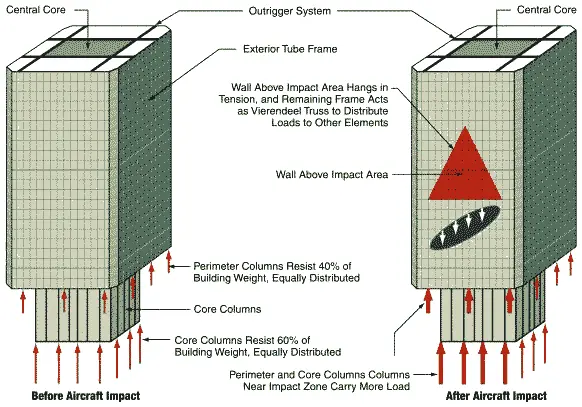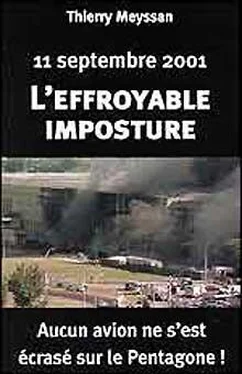Тьерри Мейссан - 11 сентября 2001
Здесь есть возможность читать онлайн «Тьерри Мейссан - 11 сентября 2001» весь текст электронной книги совершенно бесплатно (целиком полную версию без сокращений). В некоторых случаях можно слушать аудио, скачать через торрент в формате fb2 и присутствует краткое содержание. Город: Москва, Год выпуска: 2002, Издательство: Карно, Жанр: Публицистика, на русском языке. Описание произведения, (предисловие) а так же отзывы посетителей доступны на портале библиотеки ЛибКат.
- Название:11 сентября 2001
- Автор:
- Издательство:Карно
- Жанр:
- Год:2002
- Город:Москва
- ISBN:нет данных
- Рейтинг книги:5 / 5. Голосов: 1
-
Избранное:Добавить в избранное
- Отзывы:
-
Ваша оценка:
- 100
- 1
- 2
- 3
- 4
- 5
11 сентября 2001: краткое содержание, описание и аннотация
Предлагаем к чтению аннотацию, описание, краткое содержание или предисловие (зависит от того, что написал сам автор книги «11 сентября 2001»). Если вы не нашли необходимую информацию о книге — напишите в комментариях, мы постараемся отыскать её.
марионеточном, характере политической науки в России.
11 сентября 2001 — читать онлайн бесплатно полную книгу (весь текст) целиком
Ниже представлен текст книги, разбитый по страницам. Система сохранения места последней прочитанной страницы, позволяет с удобством читать онлайн бесплатно книгу «11 сентября 2001», без необходимости каждый раз заново искать на чём Вы остановились. Поставьте закладку, и сможете в любой момент перейти на страницу, на которой закончили чтение.
Интервал:
Закладка:

Figure 2-19 Redistribution of load after aircraft impact.

The resulting load distribution after the aircraft impact would have been almost identical to the load distribution incurred by strong wind from the back (i.e., from behind the plane of the page) as in the above graphic. Following the aircraft impact into the building, the structure was able to successfully redistribute the building weight to the remaining elements and to maintain a stable condition. This return to a stable condition is suggested by the preliminary analyses and also evidenced by the fact that the structure remained standing for 1 hour and 43 minutes following the impact. However, the structure's global strength was severely degraded. Although the structure may have been able to remain standing in this weakened condition for an indefinite period, it had limited ability to resist additional loading and could potentially have collapsed as a result of any severe loading event, such as that produced by high winds or earthquakes. WTC 1 probably experienced some additional loading and damage due to the collapse of the adjacent WTC 2. The extent of such damage is not known but likely included broken window and facade elements along the south face. This additional damage was not sufficient to cause collapse. The first event of sufficient severity to cause collapse was the fires that followed the aircraft impact.
2.2.1.2 Fire Development
It is estimated, based on information compiled from Government sources, that each aircraft contained about 10,000 gallons of jet fuel upon impact into the buildings. A review of photographic and video records show that the aircraft fully entered the buildings prior to any visual evidence of flames at the exteriors of the buildings. This suggests that, as the aircraft crashed into and plowed across the buildings, they distributed jet fuel throughout the impact area to form a flammable «cloud.» Ignition of this cloud resulted in a rapid pressure rise, expelling a fuel rich mixture from the impact area into shafts and through other openings caused by the crashes, resulting in dramatic fireballs.
Although only limited video footage is available that shows the crash of American Airlines Flight 11 into WTC 1 and the ensuing fireballs, extensive video records of the impact of United Airlines Flight 175 into WTC 2 are available. These videos show that three fireballs emanated from WTC 2 on the south, east, and west faces. The fireballs grew slowly, reaching their full size after about 2 seconds. The diameters of the fireballs were greater than 200 feet, exceeding the width of the building. Such fireballs were formed when the expelled jet fuel dispersed and flames traveled through the resulting fuel/air mixture. Experimentally based correlations for similar fireballs (Zalosh 1995) were used to estimate the amount of fuel consumed. The precise size of the fireballs and their exact shapes are not well defined; therefore, there is some uncertainty associated with estimates of the amount of fuel consumed by these effects. Calculations indicate that between 1,000 and 3,000 gallons of jet fuel were likely consumed in this manner. Barring additional information, it is reasonable to assume that an approximately similar amount of jet fuel was consumed by fireballs as the aircraft struck WTC 1.
Although dramatic, these fireballs did not explode or generate a shock wave. If an explosion or detonation had occurred, the expansion of the burning gasses would have taken place in microseconds, not the 2 seconds observed. Therefore, although there were some overpressures, it is unlikely that the fireballs, being external to the buildings, would have resulted in significant structural damage. It is not known whether the windows that were broken shortly after impact were broken by these external overpressures, overpressures internal to the building, the heat of the fire, or flying debris.
The first arriving firefighters observed that the windows of WTC 1 were broken out at the Concourse level. This breakage was most likely caused by overpressure in the elevator shafts. Damage to the walls of the elevator shafts was also observed as low as the 23rd floor, presumably as a result of the overpressures developed by the burning of the vapor cloud on the impact floors.
If one assumes that approximately 3,000 gallons of fuel were consumed in the initial fireballs, then the remainder either escaped the impact floors in the manners described above or was consumed by the fire on the impact floors. If half flowed away, then approximately 4,000 gallons remained on the impact floors to be consumed in the fires that followed. The jet fuel in the aerosol would have burned out as fast as the flame could spread through it, igniting almost every combustible on the floors involved. Fuel that fell to the floor and did not flow out of the building would have burned as a pool or spill fire at the point where it came to rest.
The time to consume the jet fuel can be reasonably computed. At the upper bound, if one assumes that all 10,000 gallons of fuel were evenly spread across a single building floor, it would form a pool that would be consumed by fire in less than 5 minutes (SFPE 1995) provided sufficient air for combustion was available. In reality, the jet fuel would have been distributed over multiple floors, and some would have been transported to other locations. Some would have been absorbed by carpeting or other furnishings, consumed in the flash fire in the aerosol, expelled and consumed externally in the fireballs, or flowed away from the fire floors. Accounting for these factors, it is believed that almost all of the jet fuel that remained on the impact floors was consumed in the first few minutes of the fire.
As the jet fuel burned, the resulting heat ignited office contents throughout a major portion of several of the impact floors, as well as combustible material within the aircraft itself.
A limited amount of physical evidence about the fires is available in the form of videos and still photographs of the buildings and the smoke plume generated soon after the initial attack. Estimates of the buoyant energy in the plume were obtained by plotting the rise of the smoke plume, which is governed by buoyancy in the vertical direction and by the wind in the horizontal direction. Using the Computational Fluid Dynamics (CFD) fire model, Fire Dynamics Simulator Ver. 1 (FDS1), fire scientists at the National Institute of Standards and Technology (NIST) (Rehm, et al. 2002) were able to mathematically approximate the size of fires required to produce such a smoke plume. As input to this model, an estimate of the openings available to provide ventilation for the fires was obtained from an examination of photographs taken of the damaged tower. Meteorological data on wind velocity and atmospheric temperatures were provided by the National Oceanic and Atmospheric Administration (NOAA) based on reports from the Aircraft Communications Addressing and Reporting System (ACARS). The information used weather monitoring instruments onboard three aircraft that departed from LaGuardia and Newark airports between 7:15 a.m. and 9:00 a.m. on September 11, 2001. The wind speed at heights equal to the upper stories of the towers was in the range of 10-20 mph. The outside temperatures over the height of the building were 20-21 degrees Centigrade (68-70 degrees Fahrenheit).
The modeling suggests a peak total rate of fire energy output on the order of 3-5 trillion Btu/hr, around 1-1.5 gigawatts (GW), for each of the two towers. From one third to one half of this energy flowed out of the structures. This vented energy was the force that drove the external smoke plume. The vented energy and accompanying smoke from both towers combined into a single plume. The energy output from each of the two buildings is similar to the power output of a commercial power generating station (this is the same type of misleading statement that the «Scientific» American article made, in its description of the aircraft strikes and fires in the WTC as equivalent to small nuclear weapons going off). The modeling also suggests ceiling gas temperatures of 1,000 degrees Centigrade (1,800 degrees Fahrenheit), for all of 5 minutes, until the jet-fuel burnt off, with an estimated confidence of plus or minus 100 degrees Centigrade (200 degrees Fahrenheit) or about 900-1,100 degrees Centigrade (1,600-2,000 degrees Fahrenheit).
Читать дальшеИнтервал:
Закладка:
Похожие книги на «11 сентября 2001»
Представляем Вашему вниманию похожие книги на «11 сентября 2001» списком для выбора. Мы отобрали схожую по названию и смыслу литературу в надежде предоставить читателям больше вариантов отыскать новые, интересные, ещё непрочитанные произведения.
Обсуждение, отзывы о книге «11 сентября 2001» и просто собственные мнения читателей. Оставьте ваши комментарии, напишите, что Вы думаете о произведении, его смысле или главных героях. Укажите что конкретно понравилось, а что нет, и почему Вы так считаете.












